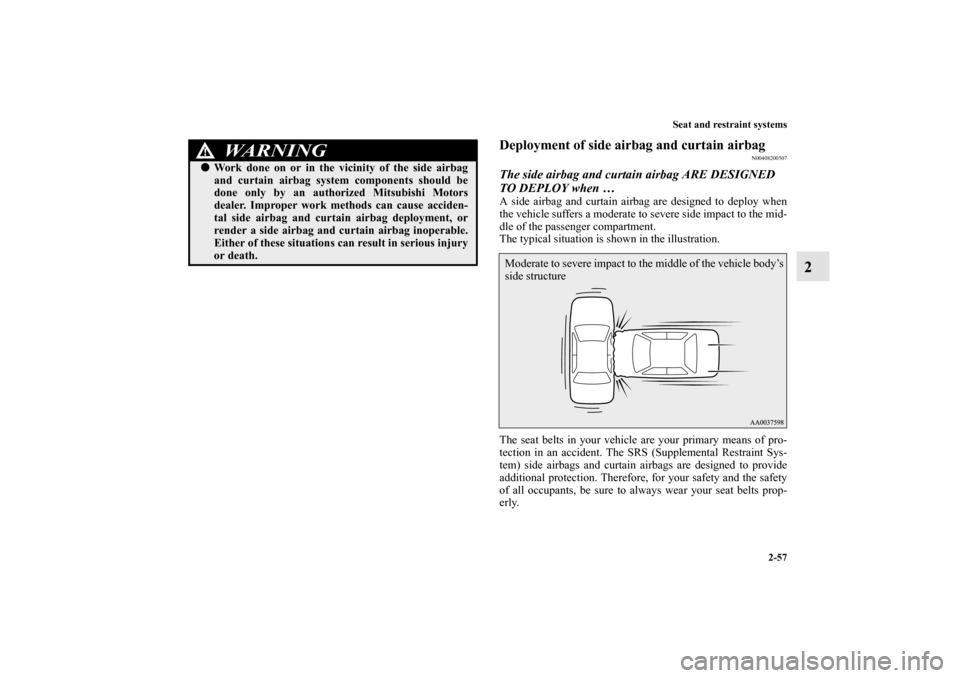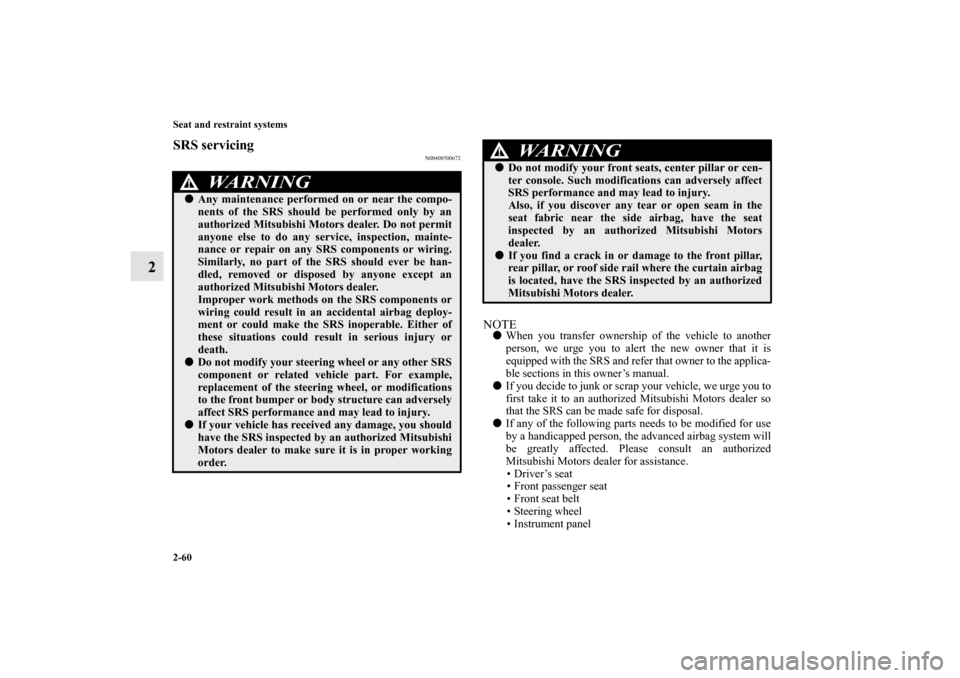Page 90 of 722

Seat and restraint systems
2-57
2
Deployment of side airbag and curtain airbag
N00408200507
The side airbag and curtain airbag ARE DESIGNED
TO DEPLOY when … A side airbag and curtain airbag are designed to deploy when
the vehicle suffers a moderate to severe side impact to the mid-
dle of the passenger compartment.
The typical situation is shown in the illustration.
The seat belts in your vehicle are your primary means of pro-
tection in an accident. The SRS (Supplemental Restraint Sys-
tem) side airbags and curtain airbags are designed to provide
additional protection. Therefore, for your safety and the safety
of all occupants, be sure to always wear your seat belts prop-
erly.
�Work done on or in the vicinity of the side airbag
and curtain airbag system components should be
done only by an authorized Mitsubishi Motors
dealer. Improper work methods can cause acciden-
tal side airbag and curtain airbag deployment, or
render a side airbag and curtain airbag inoperable.
Either of these situations can result in serious injury
or death.
WA R N I N G
!
Moderate to severe impact to the middle of the vehicle body’s
side structure
BK0150800US.book 57 ページ 2012年3月29日 木曜日 午後2時38分
Page 91 of 722
2-58 Seat and restraint systems
2
The side airbag and curtain airbag MAY NOT
DEPLOY when … In certain types of side collisions, the side airbag and curtain
airbag may not deploy, even if the deformation of the body
seems to be large, because the vehicle’s body structure is
designed to absorb the impact and to deform in order to help
protect the occupants. Some typical situations where the side
airbag and curtain airbag may not deploy are shown in the
illustrations.
Because the side airbags and curtain airbags do not protect the
occupant in all types of side collisions, be sure to always wear
your seat belts properly.
Side impact in an area away from the passenger compartment
Motorcycle or other similar small vehicle collision with the
side of vehicle
Collision with a utility pole, tree or other narrow object
BK0150800US.book 58 ページ 2012年3月29日 木曜日 午後2時38分
Page 92 of 722
Seat and restraint systems
2-59
2
The side airbag and curtain airbag ARE NOT
DESIGNED TO DEPLOY when …The side airbag and curtain airbag are not designed to deploy in
situations where they cannot provide protection to the occu-
pants. Typical situations where the side airbags and curtain air-
bags cannot provide protection are shown in the illustrations
below.
Because the side airbags and curtain airbags do not protect the
occupants in all types of collisions, be sure to always wear your
seat belts properly.
Oblique side impact
Vehicle rolls onto its side or roof
Head-on collision
Rear end collision
BK0150800US.book 59 ページ 2012年3月29日 木曜日 午後2時38分
Page 93 of 722

2-60 Seat and restraint systems
2
SRS servicing
N00408500672
NOTE�When you transfer ownership of the vehicle to another
person, we urge you to alert the new owner that it is
equipped with the SRS and refer that owner to the applica-
ble sections in this owner’s manual.
�If you decide to junk or scrap your vehicle, we urge you to
first take it to an authorized Mitsubishi Motors dealer so
that the SRS can be made safe for disposal.
�If any of the following parts needs to be modified for use
by a handicapped person, the advanced airbag system will
be greatly affected. Please consult an authorized
Mitsubishi Motors dealer for assistance.
• Driver’s seat
• Front passenger seat
• Front seat belt
• Steering wheel
• Instrument panel
WA R N I N G
!�Any maintenance performed on or near the compo-
nents of the SRS should be performed only by an
authorized Mitsubishi Motors dealer. Do not permit
anyone else to do any service, inspection, mainte-
nance or repair on any SRS components or wiring.
Similarly, no part of the SRS should ever be han-
dled, removed or disposed by anyone except an
authorized Mitsubishi Motors dealer.
Improper work methods on the SRS components or
wiring could result in an accidental airbag deploy-
ment or could make the SRS inoperable. Either of
these situations could result in serious injury or
death. �Do not modify your steering wheel or any other SRS
component or related vehicle part. For example,
replacement of the steering wheel, or modifications
to the front bumper or body structure can adversely
affect SRS performance and may lead to injury.�If your vehicle has received any damage, you should
have the SRS inspected by an authorized Mitsubishi
Motors dealer to make sure it is in proper working
order.
�Do not modify your front seats, center pillar or cen-
ter console. Such modifications can adversely affect
SRS performance and may lead to injury.
Also, if you discover any tear or open seam in the
seat fabric near the side airbag, have the seat
inspected by an authorized Mitsubishi Motors
dealer. �If you find a crack in or damage to the front pillar,
rear pillar, or roof side rail where the curtain airbag
is located, have the SRS inspected by an authorized
Mitsubishi Motors dealer.
WA R N I N G
!
BK0150800US.book 60 ページ 2012年3月29日 木曜日 午後2時38分
Page 126 of 722

Features and controls
3-31
3
• If you shift the gearshift lever into the “N” (NEUTRAL)
position and depress the accelerator pedal, increases in
the engine speed will be limited.
Starting the engineYour vehicle is equipped with an electronically controlled fuel
injection system. This is a system that automatically controls
fuel injection. There is no need to depress the accelerator pedal
when starting the engine.
The starter motor should not be run for more than 15 seconds at
a time.
To prevent battery drain, wait a few seconds between attempts
to restart the engine.
1. Make sure all occupants are properly seated with seat
belts fastened.
2. Press and hold the brake pedal down with your right foot.
3. Press and hold the clutch pedal all the way down (manual
transaxle).NOTE�For models equipped with a manual transaxle, the starter
will not operate unless the clutch pedal is fully depressed
(Clutch interlock). This is a safety feature.
WA R N I N G
!�Never run the engine in a closed or poorly ventilated
area any longer than is needed to move your vehicle
out of the area. Carbon monoxide gas, which is
odorless and extremely poisonous, could build up
and cause serious injury or death.
CAUTION
!�Do not push-start the vehicle.�Do not run the engine at high rpms or drive at high
speeds until the engine has had a chance to warm
up.�Release the ignition switch as soon as the engine
starts. Otherwise, the starter motor will be dam-
aged.
BK0150800US.book 31 ページ 2012年3月29日 木曜日 午後2時38分
Page 134 of 722
Features and controls
3-39
3
1. Make sure all occupants are properly seated with seat
belts fastened.
2. While pushing the lock release buttons (A), remove the
cover of the ignition switch.3. Insert the emergency key into the ignition switch.
4. Insert the F.A.S.T.-key into the emergency key.
BK0150800US.book 39 ページ 2012年3月29日 木曜日 午後2時38分
Page 147 of 722

3-52 Features and controls
3
4. Install a new battery with the + side (A) up.
5. Close the remote control transmitter case firmly.
6. Check the keyless entry system to see that it works.NOTE�You may purchase a replacement battery at an electric
appliance store.
�Your authorized Mitsubishi Motors dealer can replace the
battery for you if you prefer.
Door locks
N00509200491
CAUTION
!�When the remote control transmitter case is opened,
be careful to keep water, dust, etc. out. Also, do not
touch the internal components.
Coin type battery
CR2032+ side
- side
WA R N I N G
!�Make sure all doors are tightly closed and locked
while driving.
• Locked doors, in combination with the use of seat
belts, can help reduce the risk of ejection in an
accident.
• Locked doors can help keep passengers, especially
small children, from opening doors and falling out
of moving vehicles.
• Locked doors can help prevent outsiders from
gaining access to your vehicle when you slow or
come to a stop.
�Lock your vehicle whenever you leave it. Children
who get into unlocked vehicles may not be able to
get out. Children trapped inside vehicles can quickly
be overcome by heat and suffer serious injury or
death due to heat stroke.�Never leave children unattended inside a vehicle. In
addition to the risk of heat stroke, children can acti-
vate switches and controls, resulting in an injury or
fatal accident.
BK0150800US.book 52 ページ 2012年3月29日 木曜日 午後2時38分
Page 186 of 722

Features and controls
3-91
3
• If you shift the gearshift lever into the “N” (NEUTRAL)
position and depress the accelerator pedal, increases in
the engine speed will be limited.
Starting the engine
N00542200146
[For vehicles equipped with the F.A.S.T.-key.]
For information on operation for vehicles equipped with the
F.A.S.T.-key, refer to “F.A.S.T.-key: Starting the engine” on
page 3-30.
[Except for vehicles equipped with the F.A.S.T.-key.]
Your vehicle is equipped with an electronically controlled fuel
injection system, which automatically controls the release of
fuel. There is usually no need to depress the accelerator pedal
when starting the engine.
The starter should not be run for more than 15 seconds at a
time.
To prevent battery drain, wait a few seconds between attempts
to restart the engine.
1. Make sure all occupants are properly seated with seat
belts fastened
2. Insert the ignition key.
3. Make sure the parking brake is applied.
4. Press and hold the brake pedal down with your right foot.
5. Press and hold the clutch pedal all the way down (manual
transaxle).NOTE�For models equipped with a manual transaxle, the starter
will not operate unless the clutch pedal is fully depressed
(Clutch interlock). This is a safety feature.
WA R N I N G
!�Never run the engine in a closed or poorly ventilated
area any longer than is needed to move your vehicle
out of the area. Carbon monoxide gas, which is
odorless and extremely poisonous, could build up
and cause serious injury or death.
CAUTION
!�Do not push-start the vehicle.�Do not run the engine at high rpms or drive at high
speeds until the engine has had a chance to warm
up.�Release the ignition switch as soon as the engine
starts. Otherwise, the starter motor will be dam-
aged.
BK0150800US.book 91 ページ 2012年3月29日 木曜日 午後2時38分